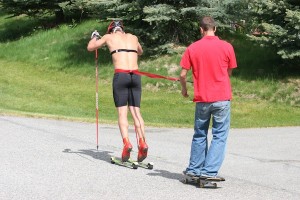
This week, we bring you a Throwback Workout from U.S. Ski Team veteran and two-time Olympian Simi Hamilton. While Hamilton, 27, currently trains with the Stratton Mountain School T2 Team in Vermont, this workout from the summer of 2010 stems from his days with the Sun Valley Ski Education (SVSEF) Olympic Development Team (ODT) in Idaho. Read original workout here.
***
[circa June 2010]
One workout that always gets Hamilton “fired up,” he said, are classic speeds: short, all-out sprints, each 20 seconds long.
Speeds are a good way to practice staying relaxed during the high speed and hard effort of a sprint, Hamilton said, because “it’s just long enough to be able to get into that consistent groove.”

“The best sprinters in the world — and I think [Andy] Newell does this really well — they’re so consistent throughout an entire sprint,” he said. “Every single double-pole, every single V2 is exactly the same. You never have to worry about adjusting from being too far forward or too far back.”
In the ODT’s version of the workout, which they do in the summer and through the early winter on snow, athletes will do three sets of six speeds, taking two minutes of easy skiing between each repetition, and seven minutes between sets.
Instead of doing all the speeds on one stretch of pavement, each set of six is done on a different type of terrain, giving athletes a chance to work on many different techniques. For the first set, the ODT will go from a standstill, using an actual start gate. (If you have one, awesome; if not, you can pretend.)
According to Hamilton, using a wand and going from a standstill is a great way to practice different start techniques, like striding off the line, or mixing in double-pole strokes.

“You’re really getting used to doing it how they do it in a World Cup,” he said. “I think it’s a great opportunity to mess around with some things, experiment a bit.”
The second set is usually drop-in speeds, which start after athletes have coasted down a hill. Drop-ins are a good way to practice high-tempo, fast-paced techniques, without expending the energy of getting up to speed.
The final set is on a steep uphill, or even around an uphill corner, using either classic striding or V1 technique. You can get creative: two weeks ago, ODT Coach Travis Jones had team members doing resisted double-pole speeds for the last set, in which athletes were attached to Jones by a bungie cord and had to pull him uphill on his skateboard.
“It made you feel like you’re one of those guys [in] the World’s Strongest Man competition,” Hamilton said.
Hamilton recommends doing the speeds with other people, going head-to-head. He said that he doesn’t see the workout as too taxing — it’s rare that his heart rate gets above threshold — which makes it a good session to use for a recovery workout or during a week with a heavy training load.
“It’s not hammering level four intervals all day,” he said, “but … when you’re really flying and feeling on, it definitely gives you a ton of confidence.”
The workout: Classic speeds
Overview: 3 sets of 6 speeds, taking 2 minutes of easy skiing between each repetition, and 7 minutes between sets.
Set 1: Start from a standstill, using an actual start gate. (If you have one, awesome; if not, you can pretend.) Practice start techniques off the line. Do six times.
Set 2: Drop-in speeds, starting after athletes coast down a hill. Practice high-tempo, fast-paced techniques. Do six times.
Set 3: Classic striding or V1 skate on a steep uphill or around an uphill corner. You can get creative (i.e. incorporate resisted double-pole speeds by attaching athletes to coach on a skateboard with a bungie cord and have athlete pull coach uphill. Do six times.



